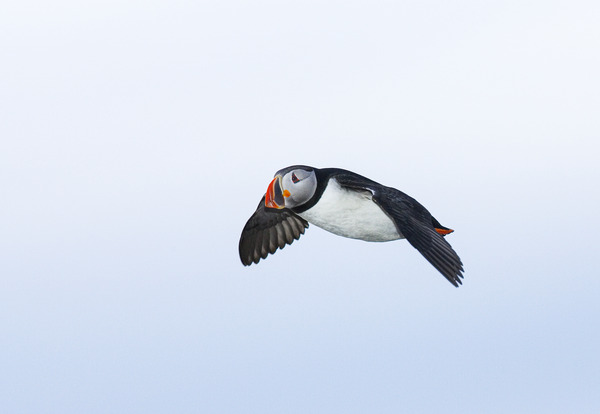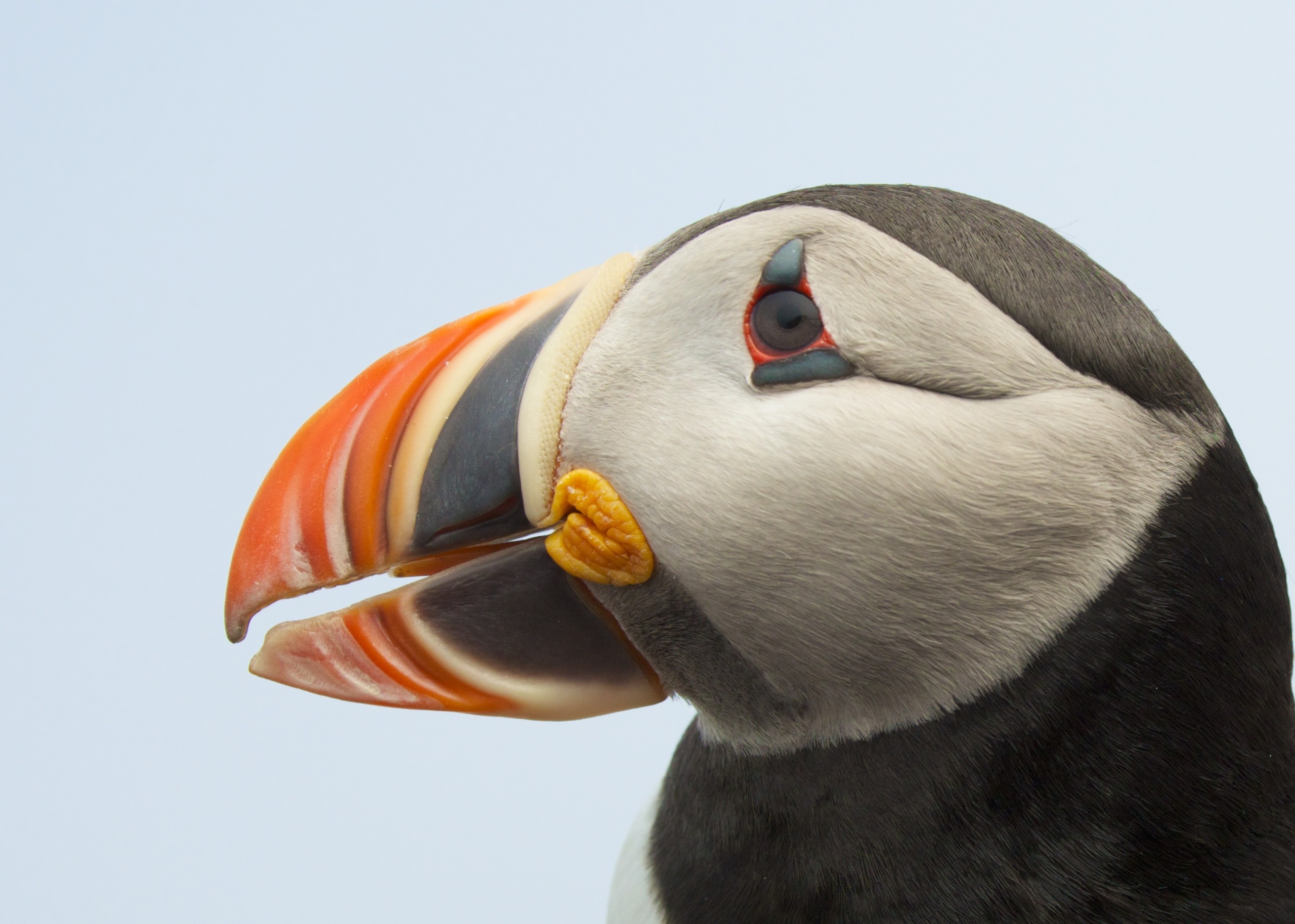 LINKED PAPER
LINKED PAPER
Sympatry of genetically distinct Atlantic Puffins (Fratercula arctica) in the High Arctic. Leigh D.M., Kersten, O., Star, B., Anker-Nilssen, T., Burnham, K., Johnson, J., Provencher, J. & Boessenkool, S. 2022 Ibis. doi: 10.1111/ibi.13153 VIEW
The Arctic is currently undergoing rapid changes in climate that has led to a northward range shift of many avian species including transarctic movement between oceans. These range shifts not only increase the likelihood of potential hybridizations between species, but also place pressure on previously established boundaries between subspecies. As a result, some unique endemic Arctic populations are at risk of admixture and possible lineage replacement by more temperate subspecies.
The Atlantic Puffin Fratercula arctica (hereafter referred to as puffin) is found throughout the North Atlantic from Spitsbergen and North Greenland to France and Maine. Whole genome sequencing has identified four distinct puffin genetic clusters, which are generally consistent with previously established subspecies delineations (Kersten et al. 2021). Subspecies body size varies latitudinally, with the smallest puffins (F. a. grabae) found the farthest south (UK and France) and the largest and most genetically distinct puffins (F. a. naumanni) found the farthest north, in the High Arctic (Spitsbergen). Mid-sized puffins (F. a. arctica) are found along the North American Atlantic coast and in Iceland/Norway/Faroes, with each respective population forming a unique genetic cluster.

Figure 1 Adult Atlantic Puffin in NW Greenland © Jack Stephens.
In northwest Greenland (hereafter referred to as Thule) is a small puffin colony (76°28’21.65”N, 70°13’12.40”W) that falls within the High Arctic range of F. a. naumanni. While the Thule population is currently made up of mostly large (~91%) bodied puffins as one would expect, it also has a smaller fraction of mid-sized individuals (~9%) (Burnham et al. 2020a). Movement data collected from both puffin size groups during the non-breeding season shows wide variation in both migration strategy and distribution, with some individuals from the same colony wintering thousands of kilometres apart (Burnham et al. 2021). It is unknown if the observed differences in body size and migratory patterns at the Thule colony are a result of extreme size differences in F. a. naumanni, or possibly dispersed members of a different genetic cluster or subspecies.

Figure 2 (a) Map presenting the 13 sites included in this study. Sites are colored according to the genetic Atlantic Puffin clusters identified previously (Kersten et al. 2021) and shading highlights the range of the recognized subspecies. The cross depicts a confirmed hybrid zone. The asterisk indicates a large-bodied Puffin that was collected offshore at the Minarets during the breeding season. (b) Genetic structure (principal components analysis; PCA) based on genome-wide variation (n = 1 116 341 single nucleotide polymorphisms) for 77 individuals. Each circle represents a sample and colors indicate membership to a genetic cluster.
From 2012 to 2015 samples were collected from three large and three mid-sized puffins at Thule. All individuals were observed at the colony for multiple years, except for a single large-sized male that was only observed in 2015. Whole genome sequencing showed that all three large-sized individuals were genetically similar, and most clustered with F. a. naumanni from Spitsbergen. Results from the three mid-sized individuals were unexpected; one individual grouped with the North American Atlantic coast cluster while the other two grouped with the Iceland/Norway/Faroes cluster. No evidence of interbreeding between large and mid-sized individuals or genetic clusters was found.
Although the large-sized Thule puffins are most closely related to puffins in Spitsbergen (F. a. naumanni) they are not panmictic, and there was greater genetic differentiation between the Thule large-sized puffins and Spitsbergen populations than between the North American Atlantic coast and Iceland/Norway/Faroes cluster. Additionally, geolocator data from the non-breeding season from the Thule and Spitsbergen populations showed no overlap in wintering areas, with large-sized Thule puffins overwintering more south and east of Spitsbergen puffins (Burnham et al 2021; Kersten et al. 2021). Based on these observed differences it is suggested that the two populations should be managed separately.
For medium-sized puffins, the lack of detectable interbreeding with large-sized puffins and the high genetic similarity to clusters with individuals originating farther south strongly suggest these individuals were dispersed from more southern natal colonies. Additionally, when migratory data from these three individuals (Burnham et al. 2021) were compared with known wintering areas for puffins from the North American Atlantic coast and Iceland/Norway/Faroes (Fayet et al. 2017), they correspond to their respective genetic clusters.
The lack of interbreeding between both size classes and genetic clusters of puffins at Thule was unexpected. Generally speaking, and particularly in seabirds, distinct sympatric subspecies are uncommon, and newly established contact zones usually result in hybridization. Similarly, hybridization between Arctic species and low-latitude taxa upon contact is increasingly common. This has been found previously for puffins in a contact zone on Bjørnøya, which is an admixed colony as a result of gene flow between Spitsbergen and more southern puffin colonies (Kersten et al. 2021). Reasons behind a lack of interbreeding at Thule could be a result of any number of causes, but may include differences in behavior, asynchronous arrival at the breeding colony resulting in a difference in timing for pair bonding.

Figure 3 Adult Atlantic Puffin in NW Greenland © Jack Stephens.
The avian assemblage in Thule is changing rapidly, with an increasing number of new species observed in the area each year, including both Horned (F. corniculata) and Tufted (F. cirrhata) Puffins that normally reside in the North Pacific (Burnham et al. 2020b). Based on our results we hypothesise that a warming climate may be allowing the northern range expansion of F. a. arctica, and that current medium-sized individuals in Thule represent the first of their body size to the area. Whether this ultimately leads to hybridization between medium and large-sized puffins is unknown (albeit likely), and Leigh et al. (2022) demonstrates the clear value that even a small number of genetic samples from remote populations can aid in our understanding of how the Arctic is changing rapidly during recent times.
References
Burnham, K.K., Burnham, J.L. & Johnson, J.A. 2020a. Morphological measurements of Atlantic puffin (Fratercula arctica naumanni) in High-Arctic Greenland. Polar Research 39: 3614. VIEW
Burnham, K.K., Burnham, J.L., Johnson, J.A. & Huffman, A. 2021. Migratory movements of Atlantic Puffins Fratercula arctica naumanni from high Arctic Greenland. PLoS One 16: e0252055. VIEW
Burnham, K.K., Burnham, J.L., Johnson, J.A., Konkel, B.W., Stephens, J. & Badgett, H. 2020b. First record of horned puffin in the North Atlantic and tufted puffin in High Arctic Greenland. Polar Research 39: 4458. VIEW
Fayet, A.L., Freeman, R., Anker-Nilssen, T., Diamond, A., Erikstad, K.E., Fifield, D., Fitzsimmons, M.G., Hansen, E.S., Harris, M.P., Jessopp, M., Kouwenberg, A.L., Kress, S., Mowat, S., Perrins, C.M., Petersen, A., Petersen, I.K., Reiertsen, T.K., Robertson, G.J., Shannon, P., Sigurðsson, I.A., Shoji, A., Wanless, S. & Guilford, T. 2017. Ocean-wide drivers of migration strategies and their influence on population breeding performance in a declining seabird. Current Biology 27: 3871-3878. VIEW
Kersten, O., Star, B., Leigh, D.M., Anker-Nilssen, T., Strøm, H., Danielsen, J., Descamps, S., Erikstad, K.E., Fitzsimmons, M.G., Fort, J., Hansen, E.S., Harris, M.P., Irestedt, M., Kleven, O., Mallory, M.L., Jakobsen, K.S. & Boessenkool, S. 2021. Complex population structure of the Atlantic puffin revealed by whole genome analyses. Communications Biology 4: 922. VIEW
Image credit
Top right: Adult Atlantic Puffin in NW Greenland © Jeff Johnson.
If you want to write about your research in #theBOUblog, then please see here.



